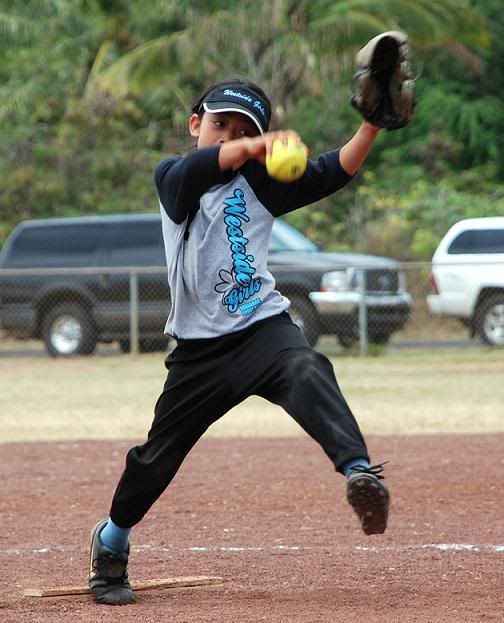Now that summer softball season has begun here in Hawaii, I'm having a chance to see some coaches work with a new bunch of players. They are working with teams who added a bunch of players as older ones moved up, or they are working with entirely new teams who are in their first season together.
One thing I noticed is the tendency for coaches to want to "jump ahead" because games are right around the corner. For me, with a new team especially, some of the things I want the girls to know before the first game are how to field a ball, how to catch a ball, and how to throw a ball. After that, basic infield/outfield coverages, maybe bunt coverage, and how to relay the ball in from the outfield. On the offensive side, we'll probably just go over how to do a sacrifice bunt and go over just a few signals (probably take one, sacrifice, and steal). That's IT unless the girls are ready for more. Obviously I'm talking about younger age groups here where you actually have to teach how to catch and how to set up a relay and such. But even for older girls on more advanced teams, I still would go over this stuff in the beginning to get a feel for where the girls are at.
When I talk about how to field, how to throw, and how to catch, I believe that these basic mechanics should be gone over with EVERYONE in EVERY season. Sometimes you need to spend more time on it, other time the girls are doing things great and you can move on faster, but I still think it should be covered with the team as a whole.
Even with infield/outfield coverages or plays (i.e. where to throw the ball and who covers what base and when) I like to run the
whole team through drills/exercises that cover these concepts. For example, I'll often have everyone take and outfield position and have them field/catch fly balls and throw to second, throw to third, and throw home. You never know who you'll need to play outfield and any given time and by putting everyone out there, you at least know you've given every person on your team some practice out there. A great infielder that never practices fly balls can do just horribly in the outfield if they ever have to play out there. This is part of why I like everyone to get some time out there every now and then. Plus it can help infielders get more comfortable tracking, and hopefully catching, those annoying bloopers that try to drop just over the infield.
When teaching relays, I always like to start out with simply setting up lines of girls and teaching them:
- which way to turn after the catch
- how to get rid of the ball quickly
- how to position their bodies before and after the throw/catch etc.
Then take it to the field and cover who is the cover for which plays before ever putting people into positions and hitting balls out for relay practice.
I think you get the idea of what I'm trying to say. I really believe it's much fairer to your players and much more effective to TEACH what you expect before just throwing the girls into the situation and trying to teach as you go.
I've seen coaches just put players in position, hit a ball outfield and tell the girls to "set up the relay." Half the time, I don't even know if the girls knew what that meant because they had never even done a relay before (this is at the 8U/10U level). Then while the ball is in the outfield they are telling the short stop, "You're the cut." I swear the girl was thinking, "What's a cut?" Because as I said, they had never practiced a relay, been taught a relay (what it is, how it's set up), nor did the coach ever go over who is the cuts are for the different outfield plays. This is what I'm talking about when I say coaches are "jumping ahead." All of that should have been introduced to the players before ever setting up a defense, hitting a ball past the outfielder, and asking the players to relay the ball home.
I understand the need and desire to practice these sorts of things before the first game comes around, but trying to teach it as you go just doesn't work as well. You still need to take the time to explain to each person what they are supposed to be doing. It's so much easier if you go over it first, explain and show the girls what's supposed to happen, let them try it AND THEN take it onto the field in a more "live" setting to practice the concept instead of jumping straight to the "live" situation and then stopping your practice each play to try to explain individually to each player what they are supposed to be doing and what is supposed to happen. Not only is this time consuming and possible confusing for the players, but they often times don't get "the whole picture" because usually the coach is only telling a particular player what their individual job is in the grand scheme of things when they try to instruct during the practice of the "whole enchilada." When you then try to put them in a different relay situation, you often have to go and do more explaining for that particular situation. It's much simpler and much more effective to cover all those basics first, then go into practicing the actual application of the skills and concept you're teaching.
One good point I learned from Cindy Bristow is that it really helps to sit down and think about what you want to have covered before the first game of the season. What is it that you want your girls to know by then? Then what do you want them to know by the half way point of the season? Are you going to go over bunt coverage before run downs or the other way around? Make a list of all the things you want to go over defensively and offensively and then prioritize the list and make a plan of what you want the girls to learn and by when.
The point is that "jumping ahead" usually doesn't get you "ahead." It only causes you to have to go back and "re-do" the foundation because you didn't do it right the first time. I have an analogy from dog training which I'm doing a lot of right now, but I'll save that for another day. AND I remember reading something that fits well with this in
Coaching the Mental Game, but I can't quite remember it right now, so I'll have to look it up and share that with you on another day as well.
Labels: coaching softball, softball performance


 My kids are back in school and the summer is coming to an end. That means Fastpitch Festival will be here before you know it as well as the Hawaii Bill Hillhouse Pitching clinic.
My kids are back in school and the summer is coming to an end. That means Fastpitch Festival will be here before you know it as well as the Hawaii Bill Hillhouse Pitching clinic.








